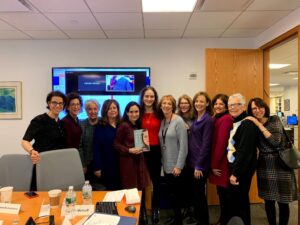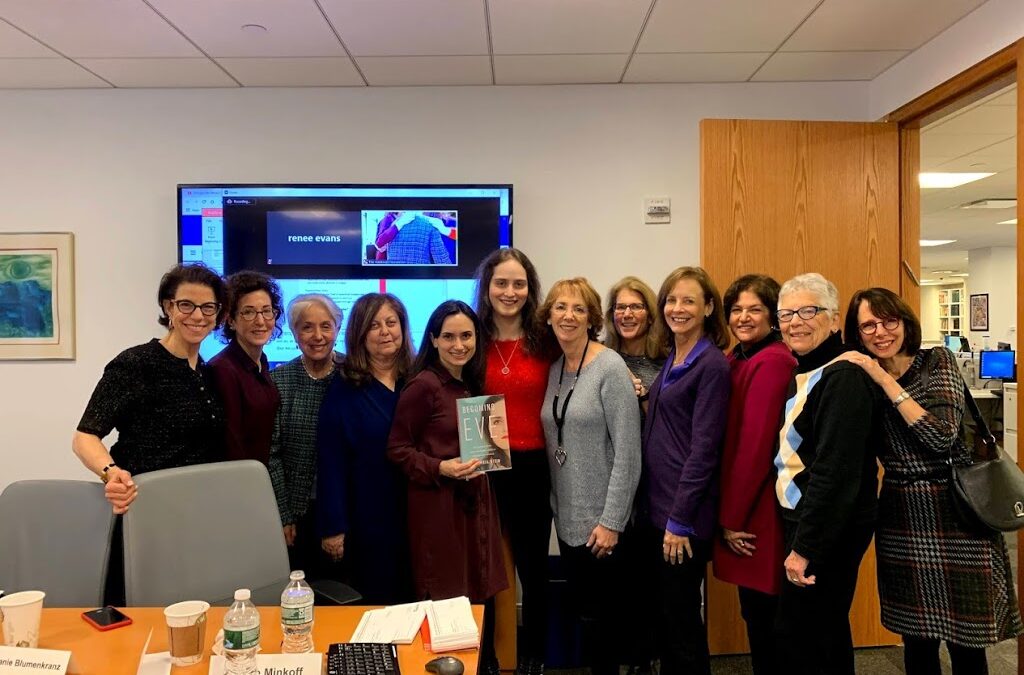Post by Rebecca Barabas
On December 10, 2019, Hadassah Foundation Board Members and guests were privileged to speak with Abby Stein, author of the recently published memoir Becoming Eve: My Journey from Ultra-Orthodox Rabbi to Transgender Woman. Abby spoke with the board about the Hasidic community, her own experiences, and what it means to be a women’s foundation in 2020, as the definition of “woman” is ever-changing.
 |
| Abby Stein and the 2019 Hadassah Foundation Board of Directors |
Abby began her presentation by introducing her personal background, then showing the Alma video “From Hasidic Rabbi to Transgender Activist, Abby Stein is Paving Her Own Way.” In this video, she walks around Williamsburg, where she grew up, speaking about her childhood. We then discussed the Hasidic community, the homogeneity within it, and how foreign it is from the Judaism that we know and practice.
We also discussed gender in general. To contradict what we might assume about Judaism’s traditional reaction to gender, as well as what she had been taught in Hasidic yeshiva, Abby asked us how many genders we thought were recognized in traditional Judaism. Not one, she told us, not two, not even three, but at least six! And, she said, up to ten, depending on whose commentary you read.
To depict this diversity of gender, Abby read Mishnah Bikkurim 4:1-5 to the group:
(א) אנדוגינוס יש בו דרכים שוה לאנשים ויש בו דרכים שוה לנשים ויש בו דרכים שוה לאנשים ונשים ויש בו דרכים אינו שוה לא לאנשים ולא לנשים: (ה) רבי מאיר אומר אנדרוגינוס בריה בפני עצמה הוא ולא יכלו חכמים להכריע עליו אם הוא איש או אשה אבל טומטום אינו כן פעמים שהוא איש פעמים שהוא אשה:
(1) An Androginus (most likely – someone who has both male and female reproductive organs) is similar to men in some ways, and to women in other ways, in some ways to both, and in some ways to neither. (5) Rabbi Meir Says: Androginus is a (gender) category of its own, (because) the rabbis could not decipher whatever s/he/they is a man or a women. However a Tumtum is not so, as at times s/he/they is fully male, and at times s/he/they is fully female (but we can’t tell which).
This passage makes it clear—gender is not simply male and female, but requires a more nuanced view within halakha. Abby recalled her first day in her college “Intro to Gender Studies” class. The professor made it clear that gender was complex and non-binary—a common view in for 21st century scholars. But “you don’t expect it from a traditional Jewish text, and forget about Jewish for a second, people don’t expect it from a second-century text. One thing is very clear: that when it comes to gender, both within Judaism and historically, it’s a lot more complex than just male and female.”
In conversation with the group, Abby was asked how she sees the role of a women’s foundation in 2020. She stressed that it is important to “make sure, very consciously, that women who are not cis-gender are very consciously included. If you think about what is our mission, how do we not just stay relevant, but make sure that we are in front of everything and how do we stay engaging in the 21st century and in 2020, that is usually a good start.”

